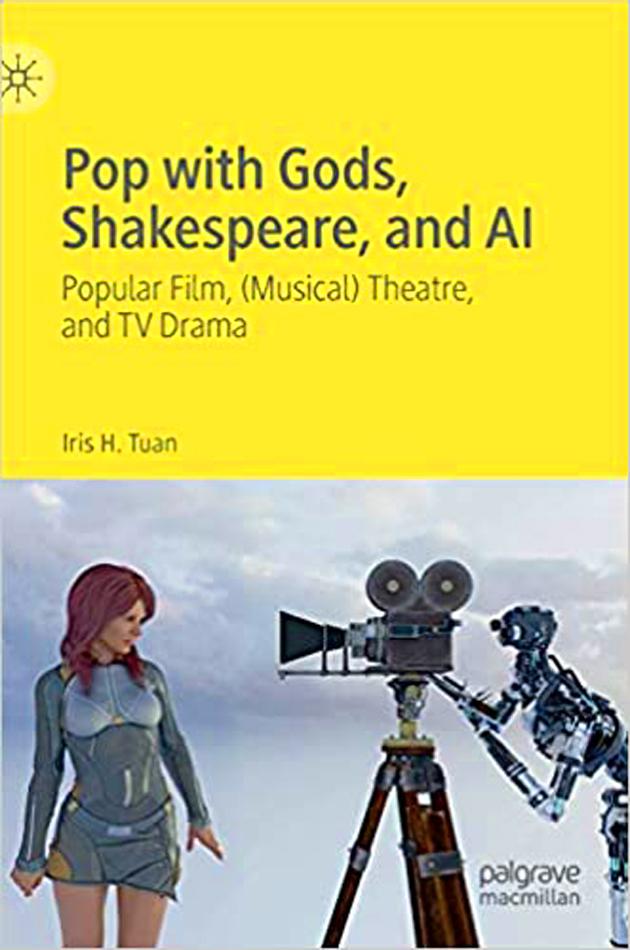The title of this varied and multi-faceted book refers to some popular films, notably the Korean movie Along with the Gods: The Two Worlds, several film versions of Shakespeare’s Romeo and Juliet and films about artificial intelligence (AI).
But there are many other topics included, such as Hakka drama in Taiwan, Robot Theater and some popular US films.
The author, Iris Tuan (段馨君), is a professor at National Yang Ming Chiao Tung University, and has been a visiting scholar at Harvard University as well as receiving a doctorate from UCLA. She has written or contributed to several previous books, all about film or dramatic performance in East Asia.

POSTMODERN ANALYSIS
The treatment of the five film versions of Romeo and Juliet rightly highlights Baz Luhrmann’s 1996 film William Shakespeare’s Romeo and Juliet but by and large Tuan is content to rely on technical terms such as “postmodern” and “symbolic” rather than go into the aesthetic qualities of the work in question.
On Luhrmann’s movie, for instance, she fails to appreciate, or show she appreciates, some of its qualities, such as the use of a Mexican fairground as the setting for the death of Mercutio and of a petrol station for the opening scene, Leonardo Di Caprio’s startling performance as Romeo or the framing of the tale by TV announcements.
Moreover, she constantly refers to the work by its full title, “Baz Luhrmann’s William Shakespeare’s Romeo and Juliet,” rarely reducing this, for instance, to “it,” so that one begins to wonder just how this portion of the text was actually put together.
Franco Zeffirelli’s 1968 version, using two teenage actors for the title roles, is also briefly discussed without evoking its human qualities, as opposed to its cinematic nature.
The 2017 movie Along with the Gods: The Two Worlds is far more fully analyzed and this excellent chapter is in many ways the book’s climax. The range of comparisons is huge, from Harry Potter to The Lord of the Rings, with citations from Aristotle, Walter Benjamin and many psychologists, largely French.
In another chapter the author considers the US musicals Chicago (2002) and The Visit (2015), focusing on the tango dance form in both products.
I found a chapter on Claude Levi-Strauss and the use of Chinese myth in the 2018 film The Monkey King: Kingdom of Women and in the theater piece Classic of Mountains and Seas (premiered 2013) difficult to follow. Those with a knowledge of Levi-Strauss’s theories, particularly Myth and Meaning (1978) and Anthropology and Myth (1991), might find it easier.
US playwright David Henry Hwang and his drama Yellow Face (2008) also feature, as well they might in a book devoted to Asian self-awareness both in Asia and outside it. Hwang had entered the 1990 controversy over whether the UK actor Jonathan Pryce or an Asian performer should play the half-Asian pimp in Miss Saigon when the show transferred from London to New York.
The chapter on Taiwan’s Hakka theater looks at the 2018 Hakka TV drama Roseki which represented the life of the Taiwanese literary scholar Lo Ho-jo (呂赫若, 1914 to 1951). The author looks especially at the role of music in the series, and also at the plot as viewed from the point of view of feminism.
There are, it has to be said, grammatical oddities here, as in this half sentence: “… General Chen Yi’s corruption rule in Taiwan from 1945 to 1950, especially the controversy 228 Event of 1947 ...” “Corruption” should surely be “corrupt,” and “controversy” should be “controversial.”
The highly popular TV drama series Story of Yanxi Palace (70 episodes, 2018) gets a whole chapter to itself. Tuan looks at Beijing Opera, the modern spectators’ feeling of affinity with the drama’s victims of oppression, and various post-feminist theories.
Also receiving attention in this enthusiastic book is the Japanese comedy Jeckyll & Hyde & So On and a range of productions, all of which the author sees as “popular,” featuring robots, from two Japanese theater pieces from 2012, Metamorphosis: Android Version and Three Sisters, based on Kafka and Chekhov respectively, to 11 films, including the Terminator movies.
AMBITIOUS WORK
All in all, Pop with Gods, Shakespeare, and AI is a very ambitious book. Its great virtue lies in its bringing together performance works from a variety of media — the author herself lists Western Literature, Chinese Literature, East Asian Studies, Shakespearean Research, Broadway Musicals, Theater Performance, Film Studies and theories of popular culture. The analysis are thorough but perhaps not ground-breaking. The author is, incidentally, possibly a controversial figure, in that she mentions in her acknowledgments, though not by name, academic colleagues who, she thinks, have held back her professional progress. Writers who exhibit Tuan’s kind of ambition might be thought to routinely attract such less than friendly attention.
It’s certainly the case that the use of chirpy, colloquial sentences combined with theorizing of the most abstruse kind, and that the addition into this mix of occasional grammatical oddities, together make for a uniquely distinctive text. But as an unrepentant monolinguist I am the last person to criticize someone who takes on a massive task such as this book represents in what I assume is her second language.
The 64 color photos are uniformly excellent and make me wonder why I don’t go to the theater more often.

June 9 to June 15 A photo of two men riding trendy high-wheel Penny-Farthing bicycles past a Qing Dynasty gate aptly captures the essence of Taipei in 1897 — a newly colonized city on the cusp of great change. The Japanese began making significant modifications to the cityscape in 1899, tearing down Qing-era structures, widening boulevards and installing Western-style infrastructure and buildings. The photographer, Minosuke Imamura, only spent a year in Taiwan as a cartographer for the governor-general’s office, but he left behind a treasure trove of 130 images showing life at the onset of Japanese rule, spanning July 1897 to

In an interview posted online by United Daily News (UDN) on May 26, current Chinese Nationalist Party (KMT) Chairman Eric Chu (朱立倫) was asked about Taichung Mayor Lu Shiow-yen (盧秀燕) replacing him as party chair. Though not yet officially running, by the customs of Taiwan politics, Lu has been signalling she is both running for party chair and to be the party’s 2028 presidential candidate. She told an international media outlet that she was considering a run. She also gave a speech in Keelung on national priorities and foreign affairs. For details, see the May 23 edition of this column,

The Taiwan People’s Party (TPP) on May 18 held a rally in Taichung to mark the anniversary of President William Lai’s (賴清德) inauguration on May 20. The title of the rally could be loosely translated to “May 18 recall fraudulent goods” (518退貨ㄌㄨㄚˋ!). Unlike in English, where the terms are the same, “recall” (退貨) in this context refers to product recalls due to damaged, defective or fraudulent merchandise, not the political recalls (罷免) currently dominating the headlines. I attended the rally to determine if the impression was correct that the TPP under party Chairman Huang Kuo-Chang (黃國昌) had little of a

At Computex 2025, Nvidia CEO Jensen Huang (黃仁勳) urged the government to subsidize AI. “All schools in Taiwan must integrate AI into their curricula,” he declared. A few months earlier, he said, “If I were a student today, I’d immediately start using tools like ChatGPT, Gemini Pro and Grok to learn, write and accelerate my thinking.” Huang sees the AI-bullet train leaving the station. And as one of its drivers, he’s worried about youth not getting on board — bad for their careers, and bad for his workforce. As a semiconductor supply-chain powerhouse and AI hub wannabe, Taiwan is seeing